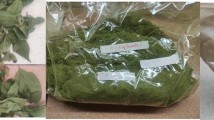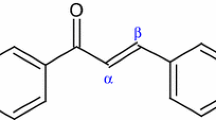Abstract
2-amino-4-(4-bromophenyl)-8-methoxy-5,6-dihydrobenzo[h]quinoline-3-carbonitrile (ABDC) was synthesized by the reaction of (2E)-2-(4 bromobenzylidene) - 6 -methoxy-3,4-dihydronaphthalen-1(2H)-one (Chalcone) with malononitrile and ammonium acetate under microwave irradiation. Chalcone was synthesised by the reaction 4-bromobenzaldehyd, 6-methoxy-1,2,3,4-tetrahydro-naphthalin-1-one under the same condition. Structure of ABDC was conformed by 1H and 13C NMR, FT-IR, EI-MS spectral studies and elemental analysis. The electronic absorption and fluorescence spectra of ABDC have been studied in solvents of different polarities, and the data were used to study the solvatochromic properties such as excitation coefficient, stokes shift, oscillator strength, transition dipole moment and fluorescence quantum yield. The absorption maximum and fluorescence emission maximum was observed red shift when increase solvent polarity n-Hexane to DMSO. ABDC undergoes solubilization in different micelles and may be used as a probe and quencher to determine the critical micelle concentration (CMC) of CTAB and SDS. The anti-bacterial activity of chalcone and its cyclized product ABDC was tested in vitro by the disk diffusion assay against two Gram-positive and two Gram-negative bacteria was determined with the reference of standard drug Tetracycline. Results showed that the ABDC is better anti-bacterial agent as compared to chalcone. The anti-bacterial activity was further supported by the quantum chemistry calculation.










Similar content being viewed by others
References
Shakil NA, Singh MK, Sathiyendiran M, Kumar J, Padaria JC (2013) Microwave synthesis, characterization and bio-efficacy evaluation of novel chalcone based 6-carbethoxy-2-cyclohexen-1-one and 2H-indazol-3-ol derivatives. Eur J Med Chem 59:120–131
Lv P, Li D, Li Q, Lu X, Xiao Z, Zhu H (2011) Synthesis, molecular docking and evaluation of thiazolyl- pyrazolines derivatives as EGFR TK inhibitors and potential anticancer agents. Bioorg Med Chem Lett 21:5374–5377
Abdullah MI, Mahmood A, Madni M, Masood S, Kashif M (2014) Synthesis, characterization, theoretical, anti-bacterial and molecular docking studies of quinoline based chalcones as a DNA gyrase inhibitor. Bioorg Chem 54:31–37
Miazga A, Ziemkowski P, Siwecka MA, Lipniacki A, Piasek A, Kulikowski T (2010) Synthesis, biological properties and anti-HIV-1 activity of new pyrimidine P1,P2-dinucleotides. Nucleosides Nucleotides Nucleic Acids 29:438–444
Liu B, Hu X, Liu J, Zhaoa Y, Huang Z (2007) Synthesis and photophysical properties of novel pyrimidine-based two-photon absorption chromophores. Tetrahedron Lett 48:5958–5962
Gondek E, Danel A, Kityk IV (2010) Star-burst 1H-pyrazolo[3,4-b]quinoline as chromophore for light-emitting diodes and photovoltaic devices. Philos Mag 90:2677–2685
Karthik S, Jana A, Saha B, Kalyani BK, Ghosh SK, Zhao Y, Singh NDP (2014) Synthesis and in vitro evaluation of charge reversal photoresponsive quinoline tethered mesoporous silica for targeted drug delivery. J Mater Chem B 2:7971–7977
Gupta VD, Tathe AB, Padalkar VS, Patil VS, Phatangare KR, Umape PG, Ramasami P, Sekar N (2013) TDDFT investigation of the electronic structures and photophysical properties of fluorescent extended Styryl push-pull chromophores containing Carbazole unit. J Fluoresc 23:1121–1138
Bindu PJ, Mahadevan KM, Naik TRR, Harish BG (2014) Synthesis, DNA binding, docking and photocleavage studies of quinolinyl chalcones. Med Chem Commun 5:1708–1717
Li G, Zhu D, Xue L, Jiang H (2013) Quinoline-based fluorescent probe for Ratiometric detection of Lysosomal pH. Org Lett 15:5020–5023
Liang F, Chen J, Cheng Y, Wang L, Ma D, Jing X, Wang F (2003) Synthesis, characterization, photoluminescent and electroluminescent properties of new conjugated 2,2′-(arylenedivinylene)bis-8-substitutedquinolines. J Mater Chem 13:1392–1399
Kim MH, Jin J, Lee CJ, Kim N, Park KH (2002) Synthesis and characterization of nonlinear optical polymers having quinoline-based chromophores. Bull Kor Chem Soc 23:964–970
Gautam P, Misra R, Siddiqui SA, Sharma GD (2015) Donor–acceptor–π–acceptor based charge transfer chromophore as electron donors for solution processed small molecule organic bulk heterojunction solar cells. Org Electron 19:76–82
Sharbati MT, Panahi F, Gharavi A (2010) Near-infrared organic light-emitting diodes based on donor-pi-acceptor oligomers. IEEE Photon Technol Lett 22:1695–1697
Ramachary DB, Jain S (2011) Sequential one-pot combination of multi-component and multi-catalysis cascade reactions: an emerging technology in organic synthesis. Org Biomol Chem 9:1277–1300
Singh KN, Singh SK (2009) Microwave-assisted, one-pot multicomponent synthesis of highly substituted pyridines using KF/alumina. ARKIVOC xiii:153–160
Khan SA, Asiri AM. (2016) Physicochemical, photophysical investigation and micellization of 1-(2,5-dimethylfuran-3-yl)-3-(2,4,5-trimethoxyphenyl)prop-2-en-1-one (DFTP) dye by fluorophotometry. J Mol Liq 428:423–428
Spartan’08 Version 1.2.0, 18401 Von Karman Ave., Suite 370, Irvine, CA 92612, USA, Wavefunction, Inc
Reichardt C (2004) Pyridinium N-phenolate betaine dyes as empirical indicators of solvent polarity: some new findings. Pure Appl Chem 76:1903–1919
Choi JY, Park EJ, Chang SH, Kang TJ (2009) Solvent effects on the Solvatochromism of 7-Aminocoumarin derivatives in neat and binary solvent mixtures: correlation of the electronic transition energies with the solvent polarity parameters. Bull Kor Chem Soc 30:1452–1458
Patra D, Barakat C (2011) Synchronous fluorescence spectroscopic study of solvatochromic curcumin dye. Spectrochim Acta A 79:1034–1041
Benniston AC, Harriman A, Rostron JP (2005) The effect of solvent polarity on the photophysical properties of 4-cyano-(4′-methylthio)diphenylacetylene: a prototypic donor-acceptor system. Phys Chem Chem Phys 7:3041–3047
Kabatc J, Osmiałowski B, Paczkowski J (2006) The experimental studies on the determination of the ground and excited state dipole moments of some hemicyanine dyes. Spectrochim Acta A 63:524–531
Bletz M, Pfeifer-Fukumura U, Kolb U, Baumann W (2002) Ground- and first-excited-singlet-state electric dipole moments of some photochromic Spirobenzopyrans in their Spiropyran and Merocyanine form. J Phys Chem A 106:2232–2236
Elmehriki AAH, Suchy M, Chicas KJ, Wojciechowski F, Hudson RHE (2014) Synthesis and spectral characterization of environmentally responsive fluorescent deoxycytidine analogs. Artificial DNA: PNA & XNA 5:29174
Jacquemin D, Perpete EA (2007) On the basis set convergence of TD-DFT oscillator strength: Dinitrophenylhydrazones as a case study. J Mol Struct THEOCHEM 804:31–34
Mancini PME, Terenzani A, Gasparri MG, Vottero LR (1995) Determination of the empirical polarity parameter E T(30) for binary solvent mixtures. J Phys Org Chem 8:617–625
Laverdant J, de Marcillac WD, Barthou C, Chinh VD, Schwob C, Coolen L, Benalloul P, Nga PT, Maıtre A (2011) Experimental determination of the fluorescence quantum yield of semiconductor Nanocrystals. Materials 4:1182–1193
Chattopadhyay N, Serpa C, Melo JS, Arnaut LG, Formosinho SJ (2001) Intramolecular charge transfer of p-(Dimethylamino)benzethyne: a case of Nonfluorescent ICT state. J Phys Chem A 105:10025–10030
Khan SA, Asiri AM (2015) Physicochemical and critical micelle concentration (CMC) of cationic (CATB) and anionic (SDS) surfactants with environmentally benign blue emitting TTQC dye. J Fluoresc 25:1749–1755
Samanta A, Paul BK, Guchha N (2015) Modulation of intramolecular charge transfer emission inside micelles: a fluorescence probe for studying microenvironment of Micellar assemblies. J Fluoresc 25:1749–1755
Khan SA, Asiri AM, Sharma K (2013) Synthesis of steroidal thiazolidinones as antibacterial agents based on the In- vitro and quantum chemistry calculation. Med Chem Res 22:1998–2004
Acknowledgments
This work was funded by the Deanship of Scientific Research (DSR), King Abdulaziz University, Jeddah, under grant No. (130-060-D1433). The authors, therefore, acknowledge with thanks DSR technical and financial support.
Author information
Authors and Affiliations
Corresponding author
Rights and permissions
About this article
Cite this article
Khan, S.A. Green Synthesis, Spectrofluorometric Characterization and Antibacterial Activity of Heterocyclic Compound from Chalcone on the Basis of in Vitro and Quantum Chemistry Calculation. J Fluoresc 27, 929–937 (2017). https://doi.org/10.1007/s10895-017-2028-z
Received:
Accepted:
Published:
Issue Date:
DOI: https://doi.org/10.1007/s10895-017-2028-z




